
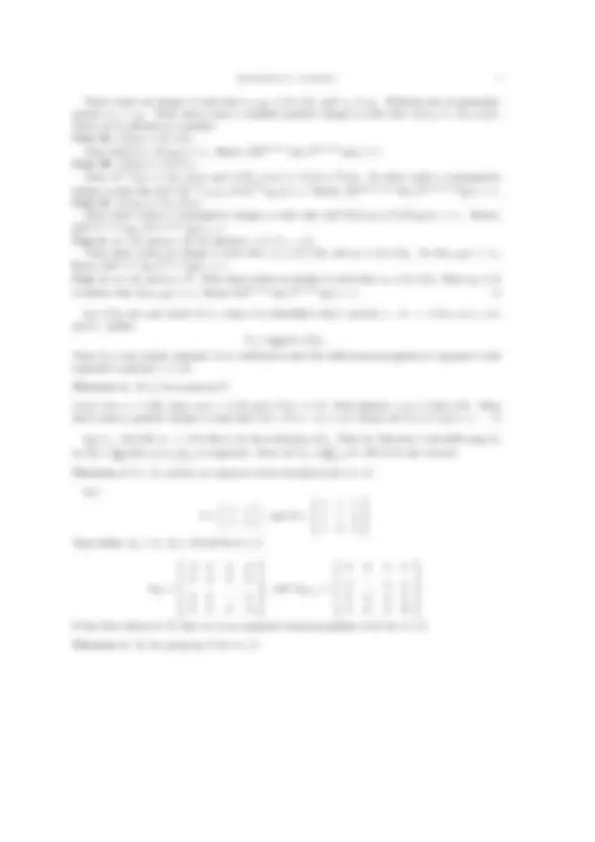

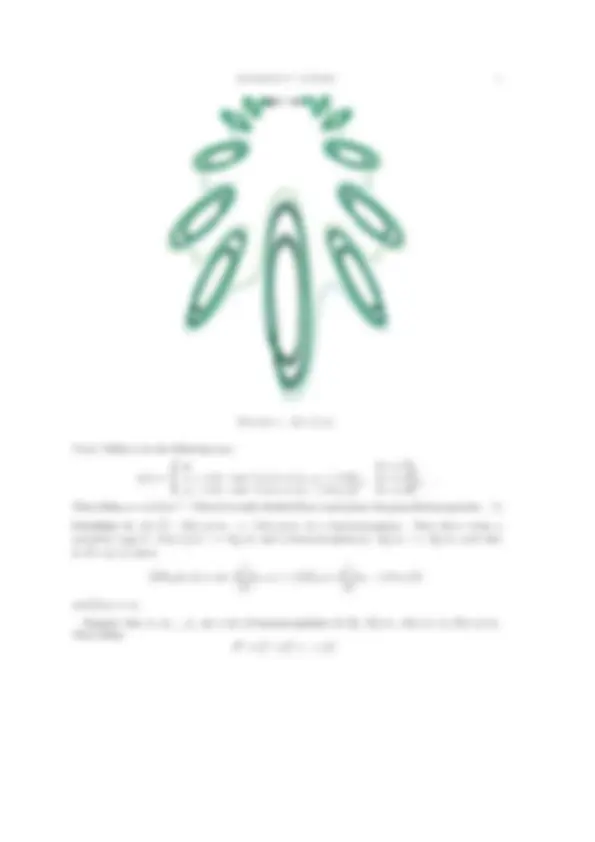
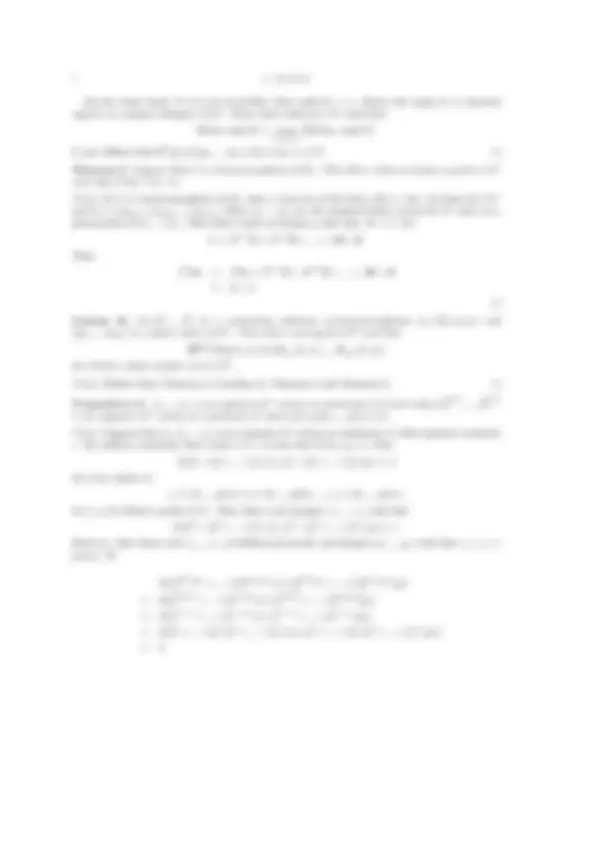
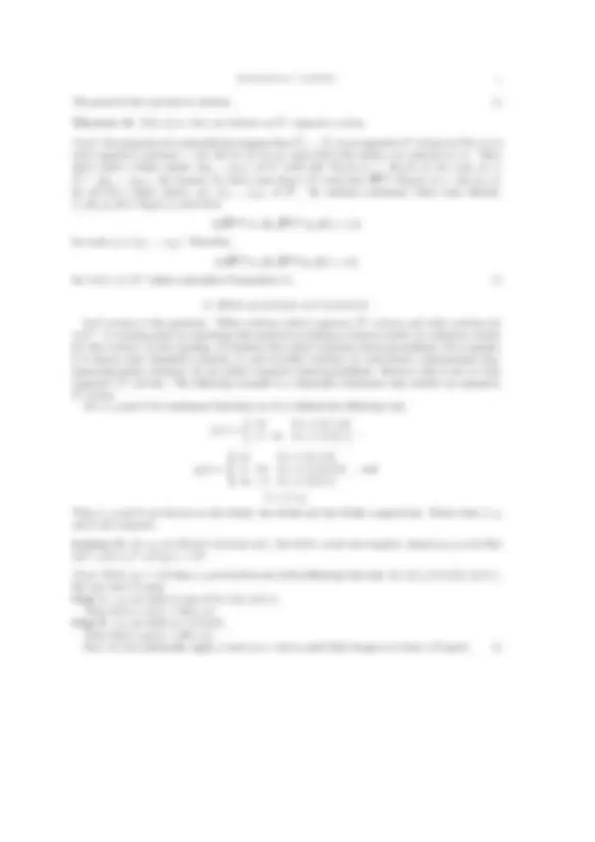
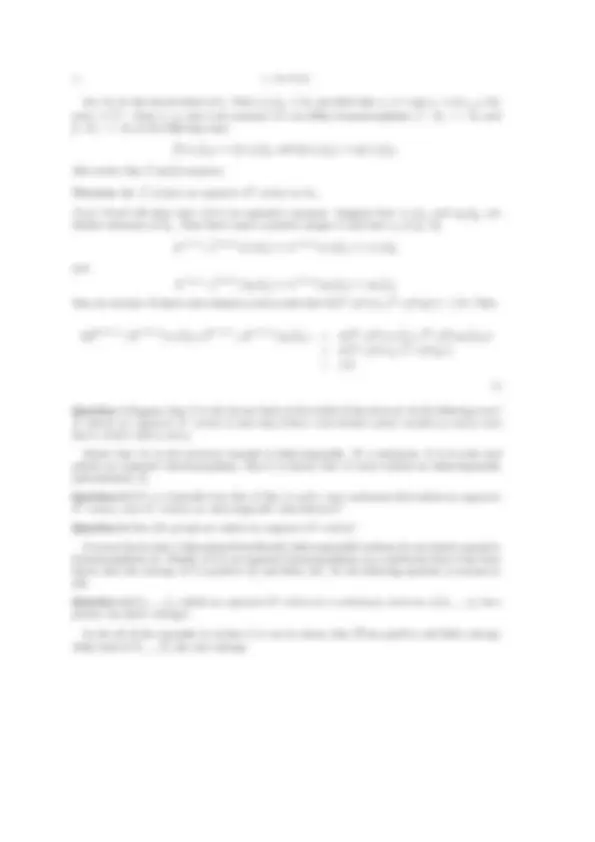


Study with the several resources on Docsity

Earn points by helping other students or get them with a premium plan


Prepare for your exams
Study with the several resources on Docsity

Earn points to download
Earn points by helping other students or get them with a premium plan
Community
Ask the community for help and clear up your study doubts
Discover the best universities in your country according to Docsity users
Free resources
Download our free guides on studying techniques, anxiety management strategies, and thesis advice from Docsity tutors
The concept of expansive zn actions on continua, a topic in topological dynamics. It includes definitions, theorems, and examples related to the existence and nonexistence of expansive zn actions on certain types of continua, as well as the relationship between expansive homeomorphisms and indecomposable subcontinua. The document also explores the relationship between entropy and expansive zn actions.
Typology: Papers
1 / 11

This page cannot be seen from the preview
Don't miss anything!







CONTINUA THAT ADMIT EXPANSIVE Zn+1^ ACTIONS BUT NOT EXPANSIVE Zn^ ACTIONS
CHRISTOPHER MOURON
Abstract. A collection {h 1 , ...hn} of commutative homeomorphisms on X generate an expansive Zn^ action on X provided that for some fixed c > 0 and every distinct x, y ∈ X there exist integers k 1 , ..., kn such that d(hk 11 ◦ hk 22 ◦ ...hk nn (x), hk 1 1 ◦ hk 22 ◦ ...hk nn (y)) ≥ c. For each set of positive integers k and n, a k-dimensional continuum Xkn is constructed such that Xnk admits an expansive Zn+1^ action but does not admit an expansive Zn^ action.
d(hn(x), hn(y)) ≥ c.
Here c is called the expansive constant. The dyadic solenoid and the torus are examples of continua that do admit expansive homeomorphisms. The arc and the simple closed curve are continua that do not admit expansive homeomorphisms. A collection {h 1 , ...hn} of commutative homeomorphisms on X generate an expansive Zn^ action on X provided that for some fixed c > 0 and every distinct x, y ∈ X there exist integers k 1 , ..., kn such that d(hk 11 ◦ hk 22 ◦ ...hk nn (x), hk 11 ◦ hk 22 ◦ ...hk nn (y)) ≥ c.
Clearly, if n = 1, then we have an expansive homeomorphism. A major question on this topic is “What continua admit expansive Zn^ actions and what continua do not?”. Shi, Zhou and Zhou have shown the nonexistence of expansive Zn^ actions on Peano continua that contain no θ-curves [8]. However, there is currently not much known on the topology of continua that admit expansive Zn actions. The purpose of this paper is to show that for any natural numbers n and m, there exists an m-dimensional continuum that admits an expansive Zn+1^ action but does not admit an expansive Zn^ action. Ma˜n´e proved that there is no expansive homeomorphism on infinite dimensional continua [3]. However, Shi and Zhou constructed an infinite dimensional continuum that admits an expansive Z^2 action [9]. In the last section, other questions will be asked and examples constructed.
X̂ = lim ←−{X, f^ }
∞ i=1 =^ {〈xi〉
∞ i=1 |^ xi^ ∈^ X^ and^ f^ (xi+1) =^ xi}.
2000 Mathematics Subject Classification. Primary: 54H20, 54F50, Secondary: 54E40. Key words and phrases. expansive homeomorphism, expansive Zn^ actions. 1
2 C. MOURON
X̂ has the subspace topology induced on it by ∏∞ i=1 X. If 〈xi〉∞ i=1, 〈yi〉∞ i=1 ∈ X̂ then define the
metric on X̂ by
̂ d(〈xi〉∞ i=1, 〈yi〉∞ i=1) =
i=
d(xi, yi) 2 i−^1
where d is the metric on X. If f is a homeomorphism on X, then it can easily be shown that X̂ is homeomorphic to X. Furthermore, the shift homeomorphism f̂ on X̂ is defined as
f̂ (〈xi〉∞ i=1) = 〈f (xi)〉∞ i=1 = 〈f (x 1 ), x 1 , x 2 , ...〉.
Notice that f̂ −k+1(〈xi〉∞ i=1) = 〈xi〉∞ i=k. Suppose that f : X −→ X is a continuous function on continuum X with the following properties: (1) If X̂ = lim ←−{X, f }∞ i=1 then the shift map f̂ is an expansive homeomorphism on X̂ with expansive constant c. (2) There exists an arc I(a, f (a)) in X from a to f (a) and an arc I(f (a), f 2 (a)) such that for every distinct x, y ∈ I(a, f (a)) ∪ I(f (a), f 2 (a)), there exists a non-negative integer n such that d(f n(x), f n(y)) > c.
Then we say that (X, f ) has Property P. Suppose that X is a continuum, a ∈ X and {[0, 1]i}ni=1 are n disjoint copies of the unit interval. Then define X(a, n) to be a new continuum that is the union of X with {[0, 1]i}ni=1 where each (^1) i ∈ [0, 1]i is identified to a.
Theorem 1. Suppose that (X, f ) has Property P. Then there exists an extension F of f on X(a, n)
such that the shift map F̂ on X̂(a, n) = lim ←−{X(a, n), F }∞ i=1 is expansive.
Proof. Let Ai be the arc [0, 1]i ∪ I[a, f (a)] where 1i is identified to a. Let Li : [0, 1]i −→ Ai be a function that takes [0, 1 /2]i linearly onto [0, 1]i and [1/ 2 , 1]i homeomorphically onto I[a, f (a)]. Then define
F (x) =
f (x) if x ∈ X Li(x) if x ∈ [0, 1]i
Let Ri = {〈xj 〉∞ j=0 ∈ X̂(a, n)|xj ∈ [0, 1]i for some j}. Then each Ri = [0, ∞)i is a ray in X̂(a, n)
that limits to a subset of X̂ and X̂(a, n) = X̂ ∪
⋃n i=1 Ri. We will now show that^ F̂^ is expansive on X̂(a, n). Let c 1 = min{d(X, [0, 1 /2]i) | i ∈ { 1 , ..., n}}
and
c 2 = min{d([0, 1 /2]i, [0, 1 /2]j ) | i, j are distinct elements of { 1 , ..., n}}.
The expansive constant for F̂ will be c′^ = min{c, c 1 , c 2 }. Suppose that x = 〈xj 〉∞ j=0 and y = 〈yj 〉∞ j=
are distinct elements in X̂ (a, n). There exists a m such that xm 6 = ym. We have 4 cases to consider: Case 1: x, y ∈ X̂. Then by the hypothesis of the theorem there exists a k such that ̂ d(F̂ k(x), F̂ k(y)) = d( f̂ k(x)), f̂ k(y)) > c ≥ c′.
Case 2: x, y ∈ Ri for some i ∈ { 1 , ..., n}.
4 C. MOURON
Proof. Proof will be for T 2 k. Proof for T 2 k+1 is similar. For ease of notation let f = A 2 k. Since f is an expansive homeomorphism, the shift map induced by f is also expansive. For condition 2, let a = [1/ 16 , 0 , ..., 0]T^. Then f (a) = [1/ 16 , 1 / 16 , 0 , ..., 0]T^ and f 2 (a) = [1/ 8 , 3 / 16 , 0 , ..., 0]T^. Let x = [x 1 , x 2 , 0 ..., 0]T^ and y = [y 1 , y 2 , 0 ..., 0]T^. So if x, y ∈ I(a, f (a)) ∪ I(f (a), f 2 (a)) then notice that x 1 ≤ y 1 if and only if x 2 ≤ y 2. Let p = x − y and have the expansive constant be 1/4. We want to find an integer q such that
||Aq 2 kp|| = ||Aq 2 k(x − y)|| = ||Aq 2 kx − Aq 2 ky|| ≥ 1 / 4.
First notice that if j is a positive integer, then
[ 1 1 1 2
F 2 j− 1 F 2 j F 2 j F 2 j+
and that
[ 1 1 1 2
F 2 j+1 −F 2 j −F 2 j F 2 j+
where Fm is the mth Fibonacci number. Also notice that if ||p|| < 1 /4 then ||Ap|| < 1. Let p = [p 1 , p 2 , 0 , ..., 0]T^. Since x and y are assumed distinct, p 1 and p 2 are not both 0. Also, since x, y ∈ I(a, f (a)) ∪ I(f (a), f 2 (a)), we have either 0 ≤ p 1 < 1 /4 and 0 ≤ p 2 < 1 /4 or 0 ≤ −p 1 < 1 / 4 and 0 ≤ −p 2 < 1 /4. Then Aj 2 kp = [F 2 j− 1 p 1 + F 2 j p 2 , F 2 j p 1 + F 2 j+1p 2 , 0 , ..., 0]T^. Hence ||Aj 2 kp|| ≥ max{F 2 j p 1 , F 2 j p 2 }. Since F 2 j can be made arbitrary large, there exists a positive integer q such that ||Aq 2 kx − Aq 2 ky|| ≥ 1 / 4. §
Let W (1, n) = Σ^22 n and for k > 1 let W (k, n) = lim ←−{Tk(a, 2 n), G}∞ i=1 where G is the extension of Ak to Tk(a, 2 n) as in Theorem 1. Consider the set {Wα(k, n)|α ∈ Zn}. Then Wα(k, n) = X̂α ∪ ⋃^2 i=1n Rα i where X̂ α is either the solenoid or the k-torus and each Rα i is a ray that limits to a
subset of X̂α. Let πi be the ith coordinate map of α ∈ Zn. Suppose that for some i ∈ { 1 , 2 , ..., n} we have πi(α) = πi(α′) − 1 and πj (α) = πj (α′) for j 6 = i. Then identify the endpoint 0α 2 i of Rα 2 i ⊂ Wα(k, n) to the endpoint 0α
′ i of^ R
α′ i ⊂^ Wα′^ (k, n).^ Let^ Z(k, n) be the resulting space. For w ∈ W (k, n) we say that (w, α) is the corresponding point of Wα(k, n) in Z(k, n). The compactification of Z(k, n) by identifying ∞ with a point, denoted by Z(k, n)/∞, is a k-dimensional continuum. Let (w, α)∞ be the corresponding point of (w, α) in the compactification. (See Figures 1, 2, and 3.) A Zn-lattice is the set of points ZnL = {[x 1 x 2 ...xn]T^ ∈ Rn| at least n − 1 of {x 1 , x 2 , ..., xn} is an integer }.
The points α ∈ Zn^ ⊂ ZnL are called the lattice points of ZnL. Suppose that α and α′^ are lattice points of ZnL such that αj = α′ j for j 6 = i and αi = α′ i − 1. Then the open arc in ZnL from α to α′
will be represented by (αi, αi + 1)α i+n = (α′ i − 1 , αi)α
′ i. The compactification of^ Z n L by identifying ∞ with a point will be denoted by ZnL/∞.
Theorem 5. Let G : Z(k, n) −→ Z(k, n) be a homeomorphism. Then there exists a monotone map φ : Z(k, n) −→ ZnL and a homeomorphism g : ZnL −→ ZnL such that φ ◦ G = g ◦ φ where
φ(Wα(k, n)) = α ∪ (
⋃^ n
i=
(αi, αi + 1/2]α i+n) ∪ (
⋃^ n
i=
[αi − 1 / 2 , αi)α i ).
EXPANSIVE Zn^ ACTIONS 5
Figure 1. Z(1, 1)/∞
Proof. Define φ in the following way:
φ(x) =
α if x ∈ X̂α αi + 1/ 2 − tan−^1 (x)/π ∈ (αi, αi + 1/2]α i+n if x ∈ Rα i+n αi − 1 / 2 − tan−^1 (x)/π ∈ [αi − 1 / 2 , αi)α i if x ∈ Rα i
Then define g = φ◦G◦φ−^1. Then it is easily checked that φ and g have the prescribed properties. §
Corollary 6. Let G˜ : Z(k, n)/∞ −→ Z(k, n)/∞ be a homeomorphism. Then there exists a monotone map φ˜ : Z(k, n)/∞ −→ ZnL/∞ and a homeomorphism ˜g : ZnL/∞ −→ ZnL/∞ such that
φ^ ˜ ◦ G˜ = g˜ ◦ φ˜ where
φ^ ˜(Wα(k, n)) = α ∪ (
⋃^ n
i=
(αi, αi + 1/2]α i+n) ∪ (
⋃^ n
i=
[αi − 1 / 2 , αi)α i )
and φ˜(∞) = ∞.
Suppose that f 1 , f 2 , ..., fn are a set of homeomorphisms of ZnL, ZnL/∞, Z(k, n), or Z(k, n)/∞. Then define f γ^ = f 1 γ 1 ◦ f 2 γ 2 ◦ ... ◦ f (^) nγn
EXPANSIVE Zn^ ACTIONS 7
where γ = [γ 1 γ 2 ...γn]T^ ∈ Zn. Likewise, if q = [q 1 q 2 ...qn]T^ then define
[f q]γ^ = f 1 q 1 γ^1 ◦ f 2 q 2 γ^2 ◦ ... ◦ f (^) nqn γn.
Theorem 7. Z(k, n)/∞ admits an Zn+1^ expansive action.
Proof. Let h be the expansive homeomorphism on W (k, n) and define H : Z(k, n) −→ Z(k, n) by H(z, α) = (h(z), α). Then for i ∈ { 1 , ..., n} define Fi : Z(k, n) −→ Z(k, n) by
Fi(z, α) = Fi(z, α 1 , ..., αi, ..., αn) = (z, α 1 , ..., αi + 1, ..., αn).
Let H,˜ F˜ 1 , ..., F˜n be the corresponding extensions of H, F 1 , ..., Fn on Z(k, n)/∞. Clearly, H, F 1 , ..., Fn and hence H,˜ F˜ 1 , ..., F˜n commute. Pick β ∈ Zn^ and consider Wβ (k, n). H˜ |Wβ (k,n) is an expansive homeomorphism of Wβ (k, n).
Let the expansive constant for H˜ |Wβ (k,n) be c 1 and
⋃^ n
i=
{(βi + 1/ 2 , βi + 3/4)β i+n} ∪
⋃^ n
i=
{(βi − 3 / 4 , βi − 1 /2)β i }.
Then define
c 2 = d(Z(k, n)/∞ − Wβ (k, n) ∪ φ˜−^1 (Q), Wβ (k, n)).
Let c = min{c 1 , c 2 }. It will be shown that c is the expansive constant for H,˜ F˜ 1 , ..., F˜n. Let x, y be distinct points of Z(k, n)/∞. There are 3 cases: Case 1: x = (x, α) and y = (y, α).
Then x 6 = y. Let γ = β − α. Then F˜γ^ (x, α) and F˜γ^ (y, α) are distinct points of Wβ (k, n). Hence there exist an integer n such that d( H˜n^ ◦ ˜Fγ^ (x, α), H˜n^ ◦ F˜γ^ (y, α)) ≥ c 1 ≥ c Case 2: x = (x, α) and y = (y, α′) where α 6 = α′. Again let γ = β − α. Then F˜γ^ (x, α) ∈ Wβ (k, n) and F˜γ^ (y, α′) 6 ∈ Wβ (k, n). Hence there exists
n ∈ Z such that H˜n^ ◦ F˜γ^ (x, α) ∈ Wβ (k, n) and H˜n^ ◦ F˜γ^ (y, α′) 6 ∈ φ˜−^1 (Q) ∪ Wβ (k, n). Thus it follows
that d( H˜n^ ◦ F˜γ^ (x, α), H˜n^ ◦ ˜Fγ^ (y, α′)) ≥ c 2 ≥ c. Case 3: x = (x, α) and y = ∞. Proof is similar to Case 2. §
A translation f : ZnL −→ ZnL is a homeomorphism of the form f (x) = x + d where d ∈ Zn. Also if x ∈ Zn^ and V is a proper subspace of Zn, then define dist(x, V) = inf{‖x − v‖ | v ∈ V}.
Theorem 8. Let f 1 , f 2 , ..., fn be translations of ZnL and {α 1 , α 2 , ..., αm} be a finite set of lattice points. Then there exists a lattice point y such that f γ^ (y) ∈ {α 1 , ..., αm} for at most a finite number of distinct γ ∈ Zn.
Proof. Let fi(x) = x + di. Then for γ = [γ 1 ...γn]T^ we have
f γ^ (x) = x + γ 1 d 1 + γ 2 d 2 + ... + γndn = x + [d 1 d 2 ...dn]γ = x + Aγ.
Notice that A is a linear operator on Zn. Thus, if A is invertible, then A is one-to-one. So for every y ∈ Zn^ there exists at most m vectors γ ∈ Zn^ such that f γ^ (y) ∈ {α 1 , ..., αm}.
8 C. MOURON
On the other hand, if A is not invertible, then rank(A) < n. Hence the range of A, denoted rng(A), is a proper subspace of Zn. Thus, there exists y ∈ Zn^ such that
dist(y, rng(A)) > max 0 ≤i≤m
{dist(αi, rng(A)).
It now follows that f γ^ (y) 6 ∈ {α 1 , ..., αm} for every γ ∈ Zn. §
Theorem 9. Suppose that f is a homeomorphism of ZnL. Then there exists an integer q and v ∈ Zn such that f q^ (x) = x + v.
Proof. If f is a homeomorphism of ZnL, then f must be of the form f (x) = Ax + d where d ∈ Zn and A = [±eρ(1) ± eρ(2)... ± eρ(n)]. Here, e 1 , ..., en are the standard basis vectors for Zn^ and ρ is a permutation of { 1 , ..., n}. Then there exists an integer q such that Aq^ = I. Let
v = Aq−^1 d + Aq−^2 d + ... + Ad + d.
Then
f q^ (x) = Aq^ x + Aq−^1 d + Aq−^2 d + ... + Ad + d = x + v. §
Lemma 10. Let F˜ 1 , ..., F˜n be a commuting collection of homeomorphisms on Z(k, n)/∞ and {α 1 , ..., αm} be a finite subset of Zn. Then there exists q, β ∈ Zn^ such that
[F˜q]γ^ (Wβ (k, n)) 6 ∈ {Wα 1 (k, n), ..., Wαn (k, n)}
for all but a finite number of γ ∈ Zn.
Proof. Follows from Theorem 5, Corollary 6, Theorem 8 and Theorem 9. §
Proposition 11. f 1 , ..., fn is an expansive Zn^ action on continuum X if and only if f q(1) 1 , ..., f^
q(n) n is an expansive Zn^ action on continuum X where q(1), q(2), ..., q(n) ∈ Z.
Proof. Suppose that f 1 , f 2 , ..., fn is an expansive Zn^ action on continuum X with expansive constant c. By uniform continuity there exists a δ > 0 such that if d(x, y) ≥ c then
d(f 1 i^1 ◦ f 2 i^2 ◦ ... ◦ f (^) nin (x), f 1 i^1 ◦ f 2 i^2 ◦ ... ◦ f (^) nin (y)) ≥ δ
for every choice of
i 1 ∈ { 0 , ..., q(1)}, i 2 ∈ { 0 , ..., q(2)}, ..., in ∈ { 0 , ..., q(n)}.
Let x, y be distinct points of X. Then there exist integers γ 1 , ..., γn such that
d(f 1 γ 1 ◦ f 2 γ 2 ◦ ... ◦ f (^) nγn (x), f 1 γ 1 ◦ f 2 γ 2 ◦ ... ◦ f (^) nγn (y)) ≥ c
However, then there exist i 1 , ..., in as defined previously and integers p 1 , ..., pn such that γj + ij = pj q(j). So
d((f 1 q (1))p^1 ◦ ... ◦ (f (^) nq( n))pn^ (x), (f 1 q (1))p^1 ◦ ... ◦ (f (^) nq( n))pn^ (y)) = d(f 1 p 1 q(1)◦ ... ◦ f (^) np nq(n)(x), f 1 p 1 q(1)◦ ... ◦ f (^) npn q(n)(y)) = d(f 1 γ 1 +i^1 ◦ ... ◦ f (^) nγ n+in(x), f 1 γ 1 +i^1 ◦ ... ◦ f (^) nγn +in(y)) = d(f 1 i^1 ◦ ... ◦ f (^) nin (f 1 γ 1 ◦ ... ◦ f (^) nγn (x)), f 1 i^1 ◦ ... ◦ f (^) nin (f 1 γ 1 ◦ ... ◦ f (^) nγn (y)))
δ.
10 C. MOURON
Let X 6 be the inverse limit of h. Then 〈xi〉∞ i=1 ∈ X 6 provided that xi ∈ I and xi = h(xi+1) for
each i ∈ Z+. Since f , g, and h all commute we can define homeomorphisms f̂ : X 6 −→ X 6 and ̂ g : X 6 −→ X 6 in the following ways:
f̂ (〈xi〉∞ i=1) = 〈f (xi)〉∞ i=1 and ̂g(〈xi〉∞ i=1) = 〈g(xi)〉∞ i=1.
Also notice that f̂ and ̂g commute.
Theorem 14. f̂ , ̂g form an expansive Z^2 action on X 6.
Proof. Proof will show that 1/9 is an expansive constant. Suppose that 〈xi〉∞ i=1 and 〈yi〉∞ i=1 are distinct elements of X 6. Then there exists a positive integer k such that xk 6 = yk. So
̂ g−k+1^ ◦ f̂ −k+1(〈xi〉∞ i=1) = h−k+1(〈xi〉∞ i=1) = 〈xi〉∞ i=k
and
̂ g−k+1^ ◦ f̂ −k+1(〈yi〉∞ i=1) = h−k+1(〈yi〉∞ i=1) = 〈yi〉∞ i=k
Also, by Lemma 13 there exist integers p and q such that d(f p^ ◦ gq^ (xk), f p^ ◦ gq^ (yk)) > 1 /9. Thus
d(f̂ p−k+1^ ◦ ̂gq−k+1(〈xi〉∞ i=1), f̂ p−k+1^ ◦ ̂gq−k+1(〈yi〉∞ i=1) = d( f̂ p^ ◦ ĝq^ (〈xi〉∞ i=k), f̂ p^ ◦ ̂gq^ (〈yi〉∞ i=k)) ≥ d(f p^ ◦ gq^ (xk), f p^ ◦ gq^ (yk))
1 / 9
§
Question 1 Suppose that X is the inverse limit of the k-fold of the interval. Is the following true? X admits an expansive Zn^ action if and only if there exist distinct prime numbers p and q such that k divides both p and q.
Notice that X 6 in the previous example is indecomposable. If a continuum X is k-cyclic and admits an expansive homeomorphism, then it is known that X must contain an indecomposable subcontinuum [4].
Question 2 If X is a chainable (tree-like, G-like, k-cyclic, any) continuum that admits an expansive Zn^ action, must X contain an indecomposable subcontinuum?
Question 3 Does the pseudo-arc admit an expansive Zn^ action?
It is now known that 1-dimensional hereditarily indecomposable continua do not admit expansive homeomorphisms [6]. Finally, if h is an expansive homeomorphism on a continuum then it has been shown that the entropy of h is positive [2] and finite [10]. So the following question is natural to ask:
Question 4 If f 1 , ..., fn admits an expansive Zn^ action on a continuum, must one of f 1 , ..., fn have positive but finite entropy?
In the all of the examples in section 2, it can be shown that H˜ has positive and finite entropy while each of F˜ 1 , ..., F˜n has zero entropy.
EXPANSIVE Zn^ ACTIONS 11
[2] H. Kato, Continuum-wise expansive homeomorphisms, Can. J. Math. 45 (1993), no. 3, 576-
[3] R. Ma˜n´e,Expansive homeomorphisms and topological dimension Trans. Amer. Math. Soc. 252 (1979), 313-
[4] C. Mouron, Expansive homeomorphisms and indecomposable subcontinua, Topology Appl. 126 (2002), no. 1-2, 13-28.
[5] C. Mouron, Tree-like continua do not admit expansive homeomorphisms, Proc. Amer. Math. Soc. 130 (2002), no. 11, 3409-3413.
[6] C. Mouron, One-dimensional hereditarily indecomposable compacta do not admit expansive homeomorphisms, preprint.
[7] W. Reddy, The existence of expansive homeomorphisms on manifolds, Duke Math. J. 32 1965 627-632.
[8] E. Shi, L. Zhou, and Y. Zhou, The nonexistence of expansive Zn^ actions on Peano continua that contain no Θ-curves, Topology Appl. 154 (2007), no. 2, 462-468.
[9] E.H. Shi and L.Z. Zhou, The nonexistence of expansive Zd^ actions on graphs, Acta Math. Sinica, English Ser. 21 (2005), pp. 15091514.
[10] P. Walters, A Introduction to Ergodic Theory, Graduate Texts in Math. 79 , Springer, New York, 1982.
Department of Mathematics and Computer Science, Rhodes College, Memphis, TN 38112 E-mail address: mouronc@rhodes.edu